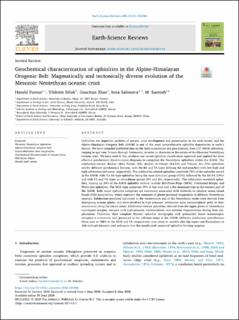| dc.description.abstract | Ophiolites are important archives of oceanic crust development and preservation in the rock record, and the Alpine-Himalayan Orogenic Belt (AHOB) is one of the most comprehensive ophiolite depositories in earth’s history. We have compiled published data on the field occurrences and geochemistry from 137 AHOB ophiolites, ranging in age from Triassic through Cretaceous, in order to characterize the nature of the Mesozoic Neotethyan oceanic crust. We have used in this synthesis our recent ophiolite classification approach and applied the most effective geochemical discrimination diagrams to categorize the Neotethyan ophiolites within the AHOB. The subduction-related, Backarc (BA), Forearc (FA), Backarc to Forearc (BA-FA) and Volcanic Arc (VA) ophiolites exhibit different geochemical features, with the BA and FA types defining the end-members with low-high and high subduction influence, respectively. The subduction-related ophiolites constitute 76% of the ophiolite record in the AHOB, with the BA type ophiolites being the most dominant group (43%), followed by the BA-FA (19%) and with FA and VA types as subordinate groups (8% and 6%, respectively). The subduction-unrelated ophiolites, making up 24% of the AHOB ophiolite archive, include Mid-Ocean Ridge (MOR), Continental Margin, and Plume type ophiolites. The MOR type comprises 19% of this total and is the dominant type in the western part of the AHOB. Both major ophiolite categories are commonly associated with tholeiitic to alkaline ocean island basalt (OIB) associations, which represent the remnants of plume-proximal magmatism in different Neotethyan seaways. Subduction-unrelated ophiolites in the westernmost end of the Neotethyan realm were derived from downgoing oceanic plates, and were involved in high-pressure, subduction zone metamorphism prior to their exhumation along the suture zones. Subduction-related ophiolites, derived from the upper plates at Neotethyan convergent margins, escaped such high-pressure metamorphism and extreme fragmentation during their emplacement. Therefore, their complete Penrose ophiolite stratigraphy with greenschist facies metamorphic overprint is commonly well preserved in the collision zones of the AHOB. Different subduction contributions (from zero to 100% in the MOR and FA, respectively) may attest to variable slab dip angles and fluctuations in slab-induced elements and sediments into the mantle melt source of ophiolite–forming magmas. | en_US |

